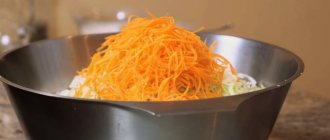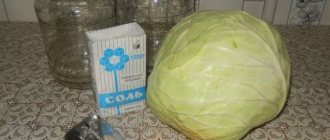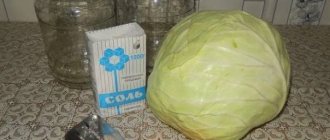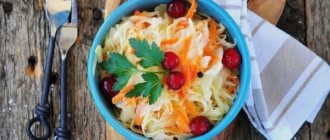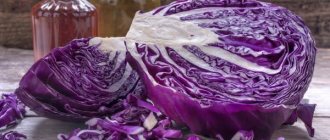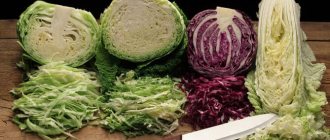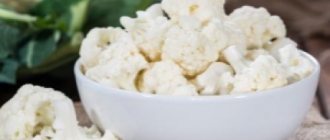There is nothing better new than the well-forgotten old. In the old days, when salt was an expensive pleasure, our ancestors prepared sauerkraut without salt and sugar. And they were right, since salt suppresses the growth of beneficial bacteria, for which pickled vegetable preparations are valued. Fermented cabbage without adding spices is much healthier than regular cabbage; it is a real natural probiotic.
Now, in the pursuit of proper nutrition, recipes are presented as something new, attributing its invention to the famous Paul Bragg. All you had to do was turn to the experience of your ancestors. The classic recipe for sauerkraut without salt does not contain spices. Although they are not prohibited, and sometimes they are added not only to improve the taste, but also for better fermentation of the product. These are black pepper, garlic, bay leaf, cumin, dill seeds, coriander, cloves, hot chili. I know that many people use dried kelp and celery. You can add various vegetables - tomatoes, broccoli, cucumbers, beets.
Sauerkraut without salt and sugar - a classic recipe
Take:
- Cabbage – head 2-2.5 kg.
- Large carrots – 1-2 pcs.
- Dill seeds.
- Cumin seeds.
Step-by-step preparation:
Chop the head of cabbage into traditional strips. Be sure to leave one of the top leaves entirely to cover the cabbage in the jar, so the top will not darken.
Grate carrots to prepare Korean vegetables. you can simply grate it on a regular grater with coarse shavings, but it will turn out more beautiful.
Combine vegetables in a common bowl, season with cumin and dill seeds. Mix gently, but do not crush with your hands to release the juice. Add spices at your discretion.
Pack the vegetables tightly into a three-liter jar, using a masher to help. Let me remind you that if you want the cabbage to become crispy, do not crush it too much.
The jars are filled up to the shoulders. Do not fill the container completely, leave room for fermentation. Cover with a whole cabbage leaf.
Fill the workpiece with water at room temperature. It is not necessary to boil it if you are confident in the good quality of your water. The liquid should completely cover the cabbage.
If possible, press down on top with a weight (suitable for the diameter of the jar). Leave the cabbage in the apartment for two days.
Soon the natural fermentation process will begin and the brine will become cloudy. From the end of the second day, start trying cabbage. If you decide that it has fermented enough, immediately put it in the cold (cellar or refrigerator) to stop the fermentation process. If the apartment is not too warm, you may have to add another day or two.
Some tips:
- Do not cut the vegetable into very thin strips.
- Don't leave cabbage unattended. On the first day, the cabbage straws will begin to absorb liquid. If you notice that there is not enough water, add a little bit.
- After a day, the vegetable will begin to return liquid, which can overflow over the top of the jar. Be on the safe side by placing a bowl underneath it.
Cabbage, fermented without salt, is reminiscent of yogurt with its beneficial bacteria in its healing effect on the body.
Features of sauerkraut
When sauerkraut is fermented for the winter without sugar, lactic acid acts as a preservative. It is formed during the fermentation process. Lactic acid helps preserve crunchiness and vitamins, and also imbues cabbage with a sweet-sour, spicy aroma.
There is no vinegar in the recipes, so the taste of the dishes is more delicate.
What are the benefits of sugar-free sourdough
Often a sugar-free recipe also lacks salt. This type of sourdough has two main advantages.
- Firstly, sugar adds extra pounds. Its absence makes this tasty snack dietary.
- Secondly, salt tends to retain fluid in the body. Thus, without these two ingredients, the beneficial properties of the vegetable increase.
Subtleties of fermentation
To make the snack tasty and healthy, it is important to follow some simple rules:
- Choose the right head of cabbage. Mid- and late-ripening varieties and hybrids are best suited for these purposes. For example, Slava, Atria-F1, Kupchikha, Podarok, Dobrovodskaya.
- Do not use an aluminum container. Choose only enamel, wood or glassware.
- Do not cut the cabbage too thin.
- If you choose to add salt to your ingredients, do not use iodized salt. Take coarse salt.
- Do not freeze cabbage or sourdough more than once.
Sauerkraut without salt with honey
You will see broccoli in the recipe. It is not necessary to put it, but it will turn out original and tasty.
You will need:
- A medium sized head of cabbage.
- Carrots – 2 pcs.
- Honey - a teaspoon.
- Lemon – 4-5 pcs.
- Broccoli is a small head.
- Dill, cloves, bay leaf, peppercorns, coriander seeds, hot chili pepper.
If desired, you can add prunes.
How to prepare:
- Cut the head of cabbage and grate the carrots. Cut the broccoli into small florets.
- Place in a three-liter container, alternating layers. Sprinkle each layer with the seasoning mixture from the list. Undesirable spices can be excluded.
- Make the brine. To do this, squeeze the juice from the lemons and add honey.
- Pour into a jar. Add water at room temperature so that the vegetables are covered a couple of centimeters above.
- Set the oppression, place it in a warm place. Since juice is released during the fermentation process, place any suitable container under the jar.
- On the third day, the sauerkraut is ready. Hide it on the refrigerator shelf for permanent storage.
For harvesting, choose only late varieties of cabbage; they contain more natural sugar, which stimulates fermentation and the release of lactic acid.
Benefit
White cabbage, unlike other vegetables, retains almost all its beneficial properties throughout the entire storage period - from autumn to spring. The fermented product brings even more benefits than the raw vegetable. Because cabbage is fermented through lacto-fermentation. In other words, there are beneficial bacteria on the surface of the head of cabbage (like any vegetable). Lactobacilli are one of them, they are also present in natural yogurt. When immersed in brine, bacteria convert the cabbage sugars into lactic acid, a natural preservative that preserves all the beneficial vitamins and nutrients while inhibiting the growth of harmful bacteria. The product contains a large number of probiotics, so fermentation is especially beneficial for the digestive system. The product is also indicated for weight loss, as it is low-calorie.
The benefits of sauerkraut primarily depend on the method of fermentation. If brine with vinegar and sugar is used during the cooking process, then this is already a pickled product, where all the beneficial properties of the dish disappear. It is natural fermentation, without the addition of third-party components, that will bring the most benefits to the body.
Cabbage, pickled without salt with beets
- White cabbage – 2 – 2.5 kg.
- Carrots – 2 pcs.
- Beets - several circles.
- Coriander, cumin, cumin, black peas, dill seeds.
Preparation:
- Chop the head of cabbage into strips 3-5 mm wide. Cut the beets into thin rings. Place in a large bowl.
- Grate the carrots using a fine mesh grater and place them in a large bowl. Mix the vegetables, sprinkling with spices as you go.
- Transfer to a jar, slightly compacting as you go. Don't forget to leave room for fermentation on top. Cover with a whole cabbage leaf to prevent the cabbage straws from scattering.
- Fill the jar with clean water, completely covering the vegetables. Leave to ferment for 2-4 days.
- Make sure that the top layer is not left without brine. Add if necessary. If a lot of gas accumulates, poke it several times with a long wooden stick.
- Determine the readiness of the preparation yourself; as soon as you decide that the cabbage is sour enough, move the jar to the cold to stop the process.
Selection and preparation of ingredients
The main ingredient of the dish is cabbage, and its quality directly affects the final result and taste of the finished fermented product, so you should approach the choice of vegetable when purchasing as responsibly as possible. Late-ripening vegetables are ideal for pickling, weighing at least 1 kg with a sugar content of more than 4% - such fruits are very juicy and tasty. The shape of a quality vegetable suitable for pickling should be round with flattened poles. Pay attention to the color of the head of cabbage: it should be snow-white, without green spots.
If you squeeze the head of cabbage on both sides with your palms, you can hear a slight crunch; if there is no such sound, it is better not to buy such a vegetable. In addition, whole heads of cabbage, without mechanical damage, are suitable for pickling. If the head of cabbage has cracks, punctures, or cuts, most likely it is already infected with fungal spores. After fermenting such a vegetable, its shelf life will be minimal and soon the cabbage will become covered with mold. Be sure to taste the purchased vegetable, it should be sweetish, without any hint of bitterness, then the finished fermented product should turn out very tasty.
We advise you to learn more about how to choose the best varieties of cabbage for pickling and pickling.
The ingredients for fermentation are prepared in advance, so that once you start working, you are not distracted by other processes. The top leaves are removed from each head of cabbage, and the head of cabbage itself is thoroughly washed. Large heads of cabbage should be cut into pieces for convenience during the chopping process. The easiest way to chop vegetables is with special shredding machines ; the width of the strips should be at least 5 mm. It is most convenient to shred vegetables on shredding graters with the cut forward so that the leaves do not protrude in the opposite direction.
If you don’t have a shredding machine, you can cut the cabbage with a knife into thin strips or use large shredding graters
The following auxiliary ingredients are used in the process of sauerkraut: carrots, apples, cranberries, beets and all kinds of spices, the quantity of which depends on the recipe . Before fermentation, carrots and beets are also thoroughly washed and peeled, then cut into thin strips (up to 3 mm thick), into rings or grated. The apples are thoroughly washed and cut into quarters or halves, removing the core. Cranberries are also washed before use.
Did you know? Sauerkraut was first prepared in China more than 2 thousand years ago, and the recipe for the dish came to Europe thanks to the Mongol-Tatars during the reign of Genghis Khan.
How to ferment with apples and mushrooms
Required:
- Cabbage – 700 gr.
- Apple.
- Mushrooms (champignons) – 220 gr.
- Cumin – 30 gr.
Cooking:
- Rinse food. Shred the cabbage.
- Cut the champignons into thin slices.
- Remove the seed from the apple. Cut into slices.
- Place the ingredients in a common container.
- Sprinkle with cumin and stir.
- Press down with a weight and leave to ferment for 4 days. Make sure there is enough water in the container. When the preparation becomes sufficiently sour, hide the salad in a cool place.
Features of storage in a house or apartment
Sauerkraut is stored at temperatures from 0 to +4°C. If the indicators are higher, the fermentation is more intense and the mass becomes acidic; if the indicators are lower, the taste will be bland.
The starter is stored in a basement or cellar where the air humidity does not exceed 85%. At home, cabbage is stored in the refrigerator.
Shelf life
The shelf life of fermented snacks is up to 12 months. If you open the jar, it is recommended to eat the contents within a week.
Recipe Variations
Cabbage is prepared not only by pickling. Marinades and brines give vegetables different flavors.
With bell pepper and carrots
More vegetables in the composition - more benefits and vitamins. This salad will not only be a tasty addition to your diet, but will also strengthen your immune system in the winter.
Ingredients:
- cabbage - 2 kg;
- sweet pepper - 400 g;
- carrots - 400 g;
- onion - 400 g;
- vinegar 9% - 100 ml;
- coarse salt - 40 g;
- sugar - 50 g;
- sunflower oil - 200 ml.
Step by step recipe:
- Remove the top leaves from the head of cabbage.
- Finely chop, sprinkle with 1 tsp. salt, knead.
- Grind carrots on a coarse grater.
- Peppers are cut into strips.
- The onion is cut into half rings.
- Mix all the vegetables.
- Add the remaining salt, vinegar, oil, sugar and stir.
- Place in clean, sterilized glass jars and seal with metal lids.
- Store in a cool place.
In brine
Ingredients:
- cabbage - 2 kg;
- bell red pepper - 200 g;
- onion - 200 g;
- carrots - 400 g;
- water - 800 ml;
- salt - 40 g;
- sugar - 20 g;
- black peppercorns - 5 pcs.;
- bay leaf - 2 pcs.
Cooking steps:
- To prepare the brine, add salt, sugar, bay leaf, and black peas to boiling water.
- The cabbage is chopped.
- The carrots are chopped on a coarse grater.
- Peppers are cut into strips.
- The onion is cut into half rings.
- The vegetables are mixed and placed in clean, dry jars without compacting.
- Pour the cooled brine over the vegetables.
- Place the jars without lids in the refrigerator for 48 hours.
- Close the containers and keep in the refrigerator for another 2 days.
With mustard seeds
Mustard seeds give the dish an original taste and increase the shelf life of the product.
Ingredients:
- cabbage - 3 kg;
- sweet pepper - 800 g;
- carrots - 500 g;
- salt - 3 tbsp. l.;
- sugar - 1 tbsp. l.;
- mustard seeds - 0.5 tbsp. l.
Cooking steps:
- The cabbage is chopped.
- The carrots are chopped on a coarse grater.
- Peppers are cut into strips.
- In a separate container, mash the cabbage.
- Add salt, sugar, mustard seeds. Stir and let sit until juice forms, about 1 hour.
- Mix all the vegetables.
- Place in clean, dry jars.
- The jars are stored open in the refrigerator for two days.
- Closed containers are placed in a cool place.
With onion
An interesting recipe for lovers of a sharper and piquant taste.
Vegetables needed:
- cabbage - 3 kg;
- large carrots - 2 pcs.;
- large onion - 2 pcs.;
- cloves - 3 pcs.
For the brine:
- water - 800 ml;
- salt - 50 g;
- sugar - 25 g.
Cooking steps:
- To prepare the brine, cooled boiled water is mixed with sugar and salt.
- Cut the cabbage into thin strips.
- The carrots are chopped on a coarse grater.
- Peppers and onions are cut into half rings.
- Mix all the vegetables.
- The vegetable mass is placed in sterilized jars and filled with brine.
- The containers are not covered with lids; they are left in a warm place for 2-3 days.
- Pierce the mass with a wooden stick to allow air to escape.
- After the specified period, close the lids and put them in a cool place.
Pickled cabbage “Snack”
To prepare such a tasty and quick snack, you can use fresh cabbage of different varieties: white, Chinese, cauliflower. A spoonful of sugar added to the recipe at the request of the hostess will give an unusual taste to the salad without vinegar.
Composition of cabbage "Snack":
- several small forks of cabbage with a total weight of 5 kg;
- tablespoons of salt are taken 2 times less than the weight of the heads of cabbage;
- carrots and red bell pepper – 3 pcs.;
- caraway.
Vegetables should be prepared: rinsed and peeled. Finely chop the forks, chop the carrots on a coarse grater, remove the seeds from the pepper and cut into strips.
All products are laid out in selected containers for marinating, sprinkled with salt and cumin. Then the mixture is thoroughly kneaded with your hands and the jars are placed under a load.
For 3 days, juice will be released, which must be poured out. After 72 hours, you can offer the salad to guests or roll up jars of salad for the winter.


